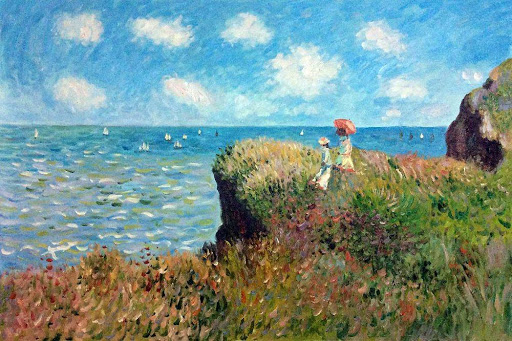The End of the Affair
According to the nineteenth-century critic Thomas De Quincy, there are two types of literature. The first is the literature of knowledge, which is didactic in tone, aiming to teach its readers firmly stated facts, functioning like an encyclopaedia.
The second is the literature of power. In De Quincy’s words, this type aims ‘to move, [speaking] ultimately . . . to the higher understanding or reason, but always through affections of pleasure and sympathy’ [1]. Although both exist to instruct, the difference is sharp and important. The literature of power is non-empirical. When appealing to the emotions, works of power like the novel provide readers with life instructions, asking us to sympathise with and understand characters -- in doing so, appealing to the primary facets of our core humanity.
Henry James’ final novel, The Golden Bowl (1904), explores the emotional consequences of a social crisis. It is a psychological work, the type that concerns itself with the spiritual, emotional, and mental lives of its upper-middle-class cast of characters, studying the ins-and-outs of their social customs and mental conundrums.
Foremost the novel deals with four characters – the Prince, Charlotte Stant, Maggie Verver and her father, Adam Verver – and their roles within a emotionally downtrodden circumstance: a marital affair between the Prince and Charlotte. The novel’s achievement is its delicate handling of this fragile subject matter.
James observes the first-person perspectives – the love-twisted worldviews – of the two adulterers in question, showing how both carefully construct their affair according to an intelligently intricate set of plans and schemes. The Prince and Charlotte successfully prevent anyone’s suspicion, behaving in a way appropriate to the customs and manners of their class in fin de siècle England. In Part One, James gives an early indication of their tactics. He tells us that it was Charlotte’s way ‘to arrange appearances’, creating a ‘perfect accord between conduct and obligation’ (p. 61). He coins this the ‘punctuality’ of their surreptitious performance – a cunning manoeuvre, a smartly coordinated pattern of mannerisms that they both adhere to, seeking to divert attention away from their frequent company.
Through a set of precise actions, the couple make the affair work. Both characters are hyper-aware of how they appear in their public and private lives. Charlotte appears unannounced at the Prince’s household; she acts cautiously when in the presence of his servants. While the butler is present, Charlotte maintains that she is there to visit her friend, the Prince’s wife, Maggie Verver; but once alone with the Prince, Charlotte reveals her true intentions and ‘[mounts] as with the whizz and the red light of a rocket’ (p. 226). In all its vivacity and colour, James’s description is crucial: it specifies how Charlotte balances her public and private life with the clear intent of mystifying the minds of those closest to both her and her secret lover. The power of James’ depiction of the adulterer’s craft relies on its correspondence with reality – on how two affair-makers would arrange and would act or, in the Jamesian sense, would perform when heavily conscious of their own dishonesty.
This also involves the dynamics of social power, and James pays close attention to both the Prince and Charlotte’s interactions with their respective spouses: father and daughter, Adam and Maggie Verver. As an example, the Prince’s attitude towards Maggie is bullish. His general outlook on life creates these dominant feelings. At one point, Charlotte observes how ‘below a certain social plane, [the Prince] never saw’ (original italics). He imagines ‘them no more than if his eyes acted only for the level of his own high head’ (p. 99). Caring little for the feelings of others makes the Prince manipulative – an attitude his wife is quick to catch onto. At a low point in the novel where she begins to suspect him, the narration turns towards Maggie’s feelings. ‘Attack,’ James narrates tensely,
real attack, from him [the Prince], as he would conduct it, was what she above all dreaded; she was so far from sure that under that experience she mightn’t drop into some depth of weakness, mightn’t show him some shortest way with her that he would know how to use again. Therefore, since she had given him, as yet, no moment’s pretext for pretending to her that she had either lost faith or suffered by a feather’s weight in happiness, she left him, it was easy to reason, with an immense advantage for all waiting and all tension (p. 395)
Like the Prince, Maggie can perform too. She stands firm, aware of the Prince’s ways, and displays the height of her inner senses. James’ ability to deal with such realistic thinking – i.e., devising fictional people who behave according to characteristic personalities – creates such powerful scenes. Moving away from the tradition of Victorian realism, James’ literature of power sends his readers into a process of edification, seeking to understand the way real people would react mentally in such difficult situations, responding to the Prince’s selfishness.
The dramatic power of unspoken knowledge drives The Golden Bowl’s inter-personal tensions. Part Two focuses on Maggie’s role in the narrative, tracing her growing realisation as to what is really going on. ‘Knowledge, knowledge, was a fascination as well as a fear,’ elucidates James, and it is Maggie’s looming knowledge which threatens the integrity of her husband’s deviation (p. 395). During the Prince’s absence, Maggie wonders curiously as to his whereabouts. ‘There she was, all round, imprisoned in the circles of the reasons it was impossible she should give – certainly give him’ (p. 372). Here James is tracing the inner torments of Maggie’s sleuth-like thoughts. He uses the image of imprisonment to express Maggie’s impasse, as she struggles to find a ‘reason’ to believe. This reveals another aspect of the psychological novel: it traces the cognitive processes of its characters – the gestation, the growth, and the progress of their thoughts. As Scottish novelist Candia McWilliam noted in her introduction to this book, James’s prose characterises the ‘texture of our thoughts’ (p. 4). Reading The Golden Bowl is like ‘watching the sky itself’, with clouds going on and on, rolling and tumbling over one another. We engage in the character’s thought processes and experience how they freely think, stretching the psychological elements of this novel to new-found lengths.
So The Golden Bowl is a work of proto-modernism, which anticipates the more free-flowing styles of later commended works, such as Virginia Woolf’s Mrs Dalloway (1925). It applies the idea of literary realism to life’s mental events. In the end, the mental lives of these characters bring their social crisis to a realistic conclusion.
The Verver family choose marital functionality over the ignominious impossibility of a double divorce. Charlotte emigrates with her husband, Mr Verver, to another country and escapes the Prince’s grasp. The ‘fine spring of the unspeakable’ sets the novel’s final instances in motion. All the characters fail to confront the reality of the affair head-on, preferring to let an inter-familial exile do all the work. They look forward towards future reconcilement, with the Prince re-affirming rather falsely that Maggie is his one and only (‘“See?” I see nothing but you’), attempting to bury all her tears in the past (p. 547).
This novel of power, appealing to our affections and sympathy, confronts adultery realistically, granting equal measure to each character’s role in the drama. Psychologically speaking, their problem remains unresolved, as James shows that such a crisis never truly leaves our minds – that such situations are never black and white. Instead, they are a complex array of grey shades. His last instruction is a difficult one to swallow -- that the crisis remains with us, and the surface level of functionality fails to direct a clear path to human happiness.
Notes:
[1] J. A. Cuddon, The Penguin Dictionary of Literary Terms and Literary Theory (4th edition, London, 1999), p. 694.
Source:
The
Golden Bowl. By Henry
James (introduction by Candia MacWilliam). London: Penguin Books, 2001.
0-14-118624-0.
 |
| The Cliff Walk Pourville by Claude Monet (1840-1926) |


Comments
Post a Comment